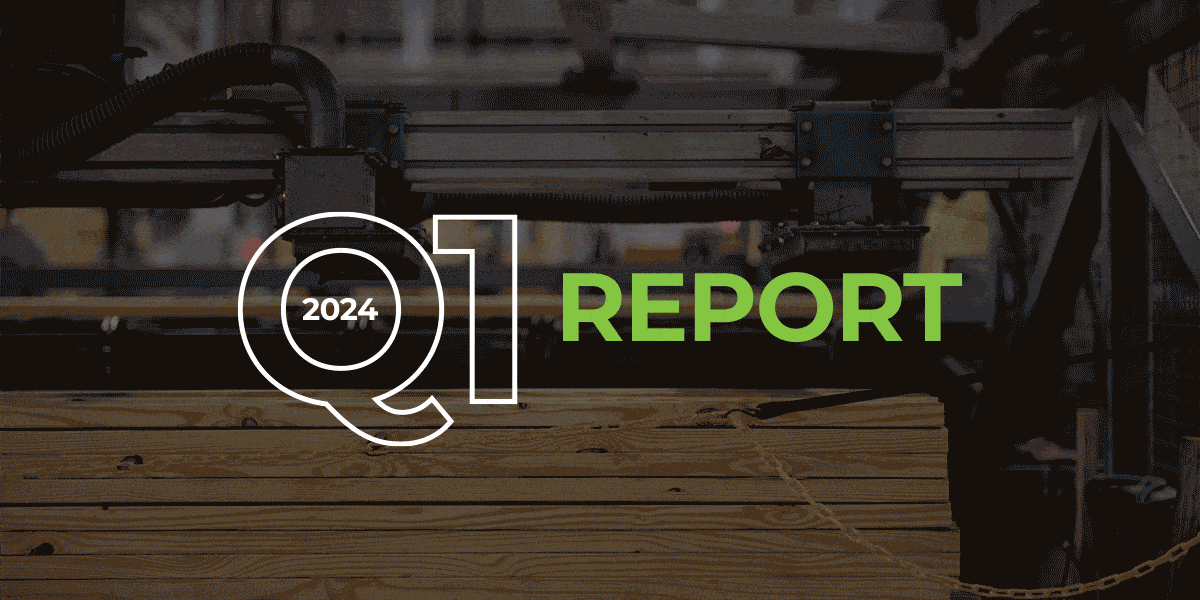HIGHLIGHTS
Program Updates
WoodWorks Market Trend Analysis: Warehouse & Manufacturing
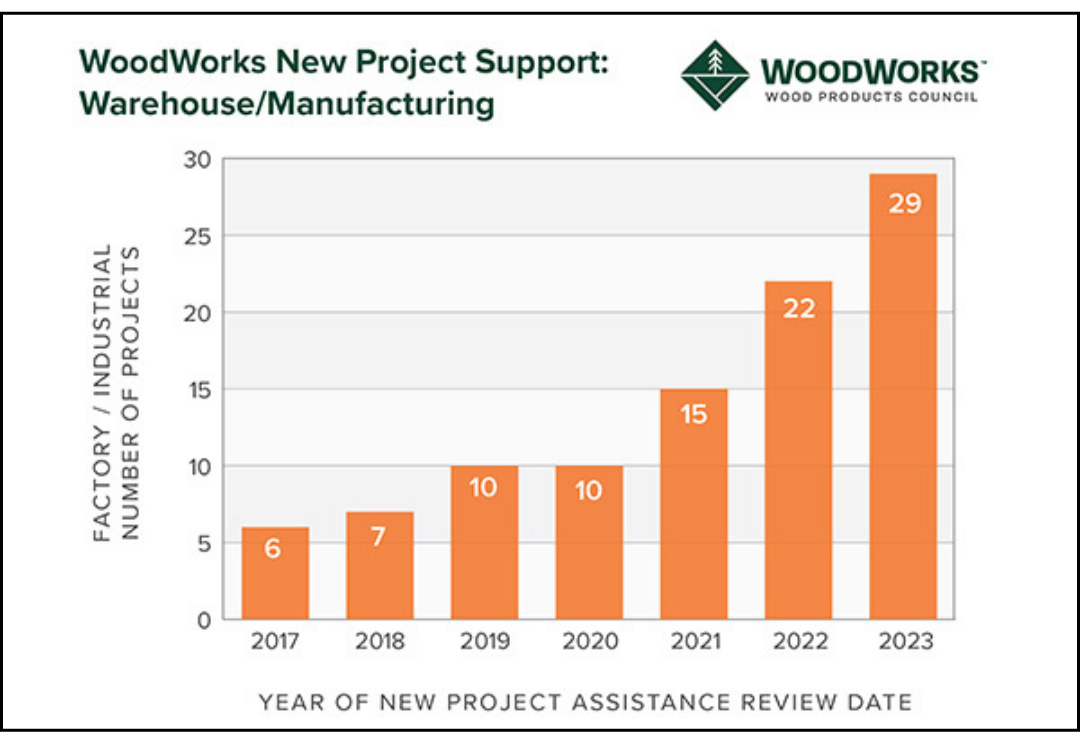
Having assisted on several high-profile warehouse and manufacturing projects, WoodWorks recently undertook a market analysis to deepen the program’s understanding of the sector’s market potential.
Warehouse/manufacturing projects experienced a surge in 2021-2022 thanks to e-commerce and infrastructure legislation. In 2023, several online retailers reduced their volume of new construction — but with 4,159 projects, this category was the second largest (behind multifamily) in the United States. While not all of these facilities can be built in wood by code, the number that can be is significant. The challenge is cost. Concrete and steel systems are highly optimized, resulting in inexpensive structures. The growing focus on net-zero carbon is opening the door to introduce wood systems and hybrid structures, but recent projects indicate that a stronger understanding of wood’s environmental and economic benefits is needed for owners to consider paying a premium. The WoodWorks team continues to identify and assist projects while pursuing research on cost-effective wood options and their carbon impacts.
Year over year, WoodWorks has increased the number of warehouse and manufacturing projects in its conversion mix. Between 2019 and 2022, only two projects supported each year went to construction; that jumped to 10 in 2023. It is still early days from a market growth perspective — the reported projects have been smaller than the market average and, in some cases, wood was used for part of the structure — but the program is seeing greater receptivity to wood use in this category.
Leveraging the awareness the program continues to build through the WoodWorks Innovation Network (WIN), case studies, and other forms of education, WoodWorks’ strategy is to engage companies with environmental and net-zero carbon goals and provide support that allows them both to achieve cost-effective wood solutions and share wood’s benefits with others. WoodWorks has published case studies on aerospace manufacturer Janicki Industries’ Building 10 and EGGER Wood Products Production Facility, and WIN includes more than 20 projects in the factory/industrial category.
From Forest to Classroom: SLB Education Workshops Transform Faculty Expertise
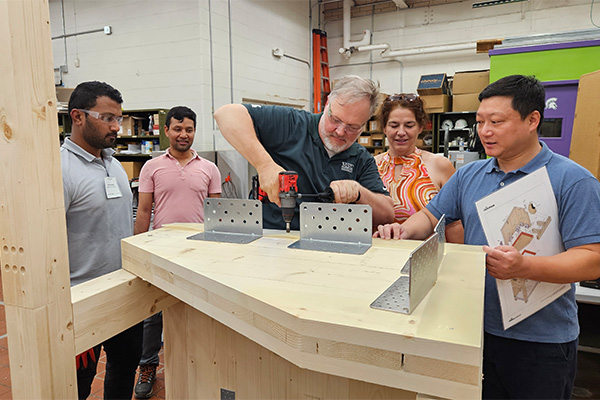
Wood education is underrepresented in many postsecondary architecture, engineering, and construction management programs across the nation. An SLB audit found that 59% of schools provide little to no exposure to wood design, mainly because there’s no faculty that can teach wood design. To significantly advance wood education, and with additional funding from the U.S. Endowment for Forestry & Communities, the SLB created five wood-focused faculty development workshops in 2024. Workshops have been held at Oregon State University, Clemson University, Auburn University, and Michigan State (pictured above), with a fifth planned at Cal Poly Pomona in October. So far this year, 80 faculty members from 60 schools nationwide have participated in these workshops, greatly enhancing their knowledge and enthusiasm for wood solutions. This newfound expertise enables educators to integrate wood design fundamentals into their curricula, familiarizing students with wood systems they can specify and realize in their future careers.
“The Auburn workshop was very well planned, crafted, and executed, with all the information that any educator needs to know about mass timber in architecture,” Carlos A. Reimers, Associate Professor at Morgan State University, told the SLB. “It was packed with material, broad in scope, dense in content, and focused on the relevant issues.”
The most recent workshop at Michigan State University, in late June, was SLB Education’s first for construction management faculty, providing a hands-on opportunity for 25 faculty members to learn from experts in the industry about mass timber construction considerations and how to include these topics in their teaching. Research from WoodWorks and the SLB has identified general contractors’ lack of knowledge about wood construction systems as a primary barrier to greater mass timber adoption.
At the current pace of investment, by the end of 2025, SLB Education will have equipped nearly 300 new faculty members with cutting-edge knowledge, up-to-date resources, and practical skills, enabling them to incorporate wood design into their curricula to influence future architects, engineers, and contractors. Given that there are 2,765 full-time architecture faculty and approximately 2,500 full-time engineering faculty at U.S. universities, this initiative will directly affect nearly 6% of the total, significantly enhancing the presence of wood design education across the country. A post-workshop survey indicated that each faculty member will influence an average of 50 students in the following academic year, demonstrating the exponential impact of this program.
Contact Director of Education Reed Kelterborn to recommend additional schools.
The AWC Launches New Construction Fire Safety App
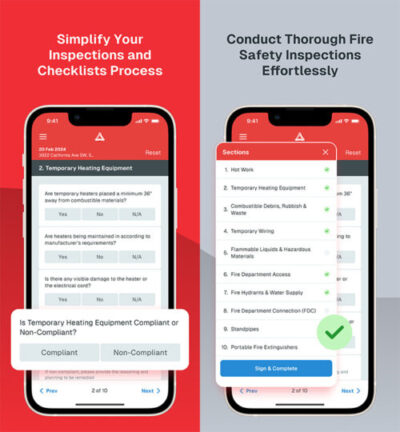
The AWC released a new app that is designed to support builders and inspectors, promote safe construction practices, and help meet construction site code requirements. The Construction Fire Safety Checklist, or CFS Checklist, contains a complete fire inspection checklist that meets the requirements of the 2021 International Fire Code.
The AWC developed the app in collaboration with the Construction Fire Safety Coalition (CFSC), which brings together the construction industry, building departments, and fire departments from across the country to reduce the frequency and severity of construction fires through education and awareness. The coalition requires its members to be familiar with and promote construction fire safety best practices. With tools such as the CFS Checklist, the AWC and CFSC help reduce construction fires that draw negative attention to wood construction.
The fire service, building inspectors, and construction managers all have unique needs and roles to play in promoting safe construction practices, but all communicated a need for a streamlined and shareable way to ensure code compliance, prompting development of the app. Its code-compliant questions and user-friendly interface encourage users to be proactive in identifying risks, which will help prevent construction site fires whether the checklist is being used by the construction manager or fire inspector.
In less than a month since the app’s release, more than 600 individuals have downloaded it as a result of a targeted digital ad campaign that focuses on fire and building officials.
The app is available for both Apple and Android users and can be downloaded on phones or tablets. It is available on the Google Play and Apple stores.
Updated Resource Library Boosts AEC Audience Targeting
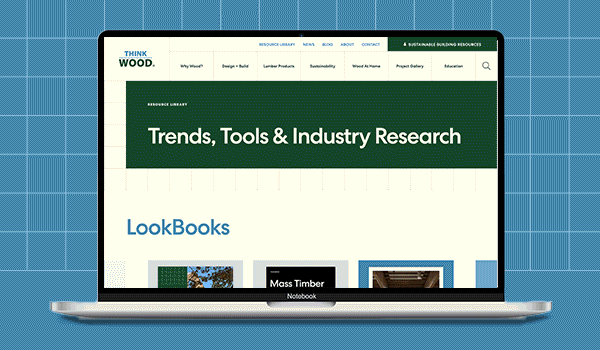
Think Wood’s updated resource library offers access to the program’s downloadable resources to enhance the development and nurturing of its leads in the architecture, engineering, and construction audiences. The library collects assets such as in-depth reports focusing on specific building segments, video interviews with industry leaders, and portfolios of innovative projects to educate and inspire professionals while helping them design their projects better with lumber. Previously scattered across different sections of the website, this new portal gathers all the assets in one easily navigable place for one-stop shopping for information about the possible applications of wood structural systems.
The resource library and its featured content are used for lead generation with Think Wood’s AEC professional target audience and for lead nurturing with existing users, as repeat engagement with Think Wood resources has been proved to move them closer to specifying lumber for their projects. Each registration page offers users (new and old) the chance to ask a project assistance question, at which point the user is referred to a WoodWorks expert, becoming a qualified project lead.
Recently launched assets, including a Single-Family Home LookBook, a Mass Timber LookBook, 5 Mass Timber Higher Ed Projects That Pencil Out, 5 Women Leaders in Mass Timber, and a listicle, 13 Mass Timber Design Resources You Won’t Want to Miss, have already combined to produce more than 1,235 new contacts and 93 project leads to deliver to WoodWorks.
Spotlight
Top Developers Seeing Mass Timber Buildings Outperform Concrete and Steel
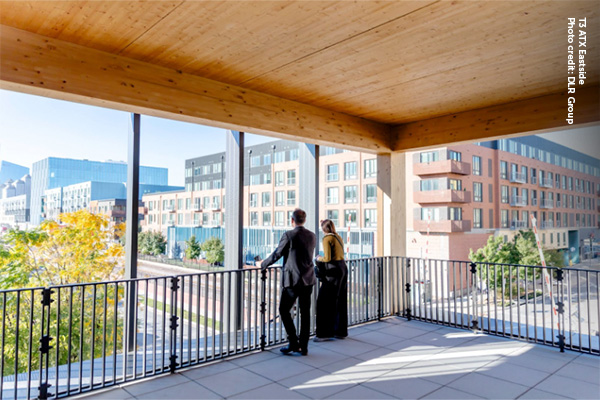
While the environmental case for mass timber construction is undeniably strong, the business case must be equally powerful in order for it to continue to expand market share and drive demand for lumber in commercial and multifamily development. At a recent conference, Bisnow reports that two of commercial real estate’s biggest developers are seeing that business case come to fruition, with buildings constructed using mass timber leasing up faster and commanding premium rents compared with those solely using standard building materials.
“Directors from Hines and Howard Hughes Holdings told the audience . . . that the cost of mass timber buildings is also coming down and that the amount of carbon used in construction is significantly less than with buildings developed using more concrete and steel,” reporter Mike Phillips writes. He points to Hines’ recently completed T3 ATX Eastside mixed-use project, which is 47% leased at rates equivalent to new prime office buildings, and Howard Hughes’ One Bridgeland Green office building in Cypress, Texas, which is 80% leased ahead of completion.
The SLB’s Think Wood program recently profiled T3 ATX Eastside in a video targeting architects and developers, featuring architects from the project’s designer, DLR Group, and Hines Managing Director Alex Ohrn, who noted that having potential tenants look, touch, and smell the difference between mass timber and concrete makes a huge difference in leasing performance.
“We believe that will translate into a value premium,” Ohrn says, “as well as higher rent and higher income that is capturable, and really that comes from the sustainability, the premium design, as well as the carbon story, the benefits to investors, and also the potential to reduce CapEx in the future.”
Industry Resources
FEA's Housing Dashboard
This housing dashboard is provided compliments of Forest Economic Advisors (FEA)
View the June Housing Dashboard
View the July Housing Dashboard
Virginia Tech's Monthly Housing Report
This monthly housing commentary report is a free service of Virginia Tech and is intended to help one gauge future business activity in the U.S. housing market.
May 2024 Reports (released in July 2024)
Part A: May Housing Commentary
Part B: May Economic Conditions


